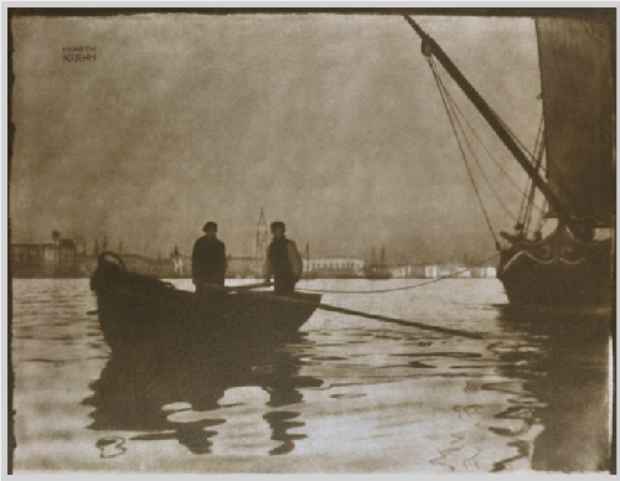"Heinrich Kuehn and the Photo-Secession: Selected Works" Exhibition
Hans P. Kraus, Jr. Fine Photographs

This event has ended.
Hans P. Kraus Jr. Fine Photographs presents Heinrich Kuehn and the Photo-Secession: Selected Works. This exhibition complements two current exhibitions in New York City: Heinrich Kuehn and his American Circle at the Neue Galerie and Heinrich Kuehn:Viennese Photo-Secessionist at Howard Greenberg Gallery.
Kuehn, an Austrian photographer, was influential in the Pictorialist movement, which strove to create photography that would be accepted as fine art. More than 25 photographs, from 1845-1914, will be on view at Hans P. Kraus Jr. Fine Photographs. In addition to the work of Kuehn, the exhibition includes Alvin Landgon Coburn, Frederick Evans, George Seeley, Edward Steichen, Alfred Stieglitz, and Hans Watzek, as well as earlier masters of photography Julia Margaret Cameron and Hill & Adamson who inspired the Pictorialists.
Before the turn of the 20th century, the Pictorialists experimented with processes and manipulated the photographic image to create tonalities and textures that resembled drawings, prints or paintings. They consciously distanced themselves from earlier approaches to photography that, they felt, emphasized scientific and technical expertise over artistic expression.
Heinrich Kuehn (1866-1944) was at the forefront of this movement in Vienna, which included his colleague Hans Watzek (1848-1903) and others. Like-minded photographers in Britain established The Linked Ring in 1892, also dedicated to promoting photography as fine art. Frederick Evans (1853-1943) and Alvin Langdon Coburn (1882-1966) were both prominent early members. Alfred Stieglitz (1864-1946) was the single most important figure in American photography at the turn of the century. He was a vociferous advocate for Pictorialism in America and in 1902 established the group known as the Photo-Secession in 1902, which he described as “probably the most radical and exclusive body of photographers.” His first issue of Camera Work was published in January 1903, and he and Edward Steichen (1879-1973) were the most accomplished and influential photographers in the Photo-Secession. Both had European roots.
The international boundaries for Pictorialism were quite fluid. Kuehn and Stieglitz were invited to join The Linked Ring. Their photographs were exhibited together in Europe. From the U.S. both Stieglitz and Steichen maintained relationships and corresponded with Kuehn for many years, and Stieglitz invited members of The Linked Ring to be part of the Photo-Secession.
Kuehn had begun photographing in Austria as a young amateur. He subsequently inherited the family fortune at his father’s death in 1893, which freed him to pursue his photographic and scientific endeavors. He flourished, and in 1906, Stieglitz dedicated an exhibition at 291, his gallery of the Photo-Secession, to Kuehn.
Kuehn’s 1897 Sailing Boat, a gum bichromate print, exemplifies the Pictorialist aesthetic. The delicate seascape depicts light and shadow almost as brushstrokes. At first glance, its blue toning on textured paper seems to be an Impressionist watercolor. Heinrich Kuehn and the Photo-Secession: Selected Works includes a selection of landscapes by Kuehn as well as touching portraits of his family and friends.
Steichen and Stieglitz met in 1900 and worked closely toward the shared goal of promoting a new kind of art photography. Steichen was a noted portraitist throughout his long career. On view is one of his early works, a carbon print of the actress Eleanora Duse, 1903. Her emotional, yearning expression and luminous face against her shadowy form and background, as well as the clearly visible brushstrokes over the entire surface, contribute to this portrait being a consummate example in the Pictorialist canon.
Frederick Evans and Alvin Langdon Coburn are represented with atmospheric city views, landscapes and architectural interiors. These photographers chose a wide range of subjects, but their work shared the softened focus and lush surface quality that characterize Pictorialist photographs. York Minster: Door to Chapter House, c. 1900, is an example of Frederick Evans’s platinum prints and of his luminous cathedral views. In this photograph, he successfully captured architectural details, yet the undefined space beyond this open door dominates the composition, a recurring motif in his photographs. Coburn’s enchanting Wings!, 1914, a gum over platinum print, silhouettes an airplane overcoming gravity, an example of George Bernard Shaw’s description of Coburn’s work as “poetic”.
Stieglitz recognized the talents of the great pioneer photographers and he published their work in several issues of Camera Work. He wrote glowingly about the portraits of D. O. Hill (1802-1870) and Julia Margaret Cameron (1815-1879). Cameron did not ally herself with any movement, yet her work certainly defined the Pictorialist ideals. She was criticized in her own day for the technical imperfections and gauzy focus of her photographs, but Stieglitz celebrated her and critical and popular appreciation for her photographs has never waned.
The exhibition includes four portraits by D. O. Hill & Robert Adamson (1822-1848), the undisputed masters of early portraiture, and three by Cameron. Her photograph, Sir J.F.W. Herschel, 1867, captures the prominent scientist and inventor at the end of his life. It is easy to understand why Cameron’s portraits appealed to Stieglitz. Herschel’s weathered, lined face and shadowed gaze is so much more than a slavish likeness of a prominent personality.
Media
Schedule
from May 23, 2012 to June 29, 2012